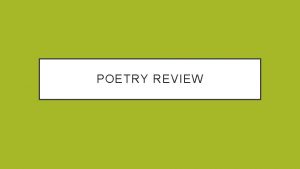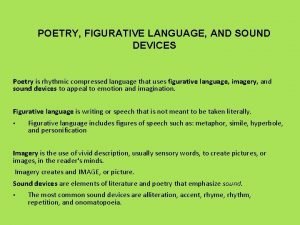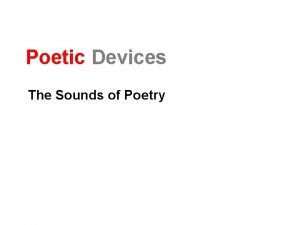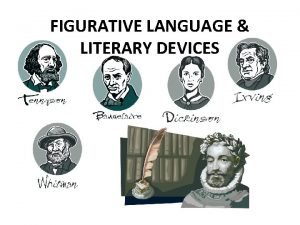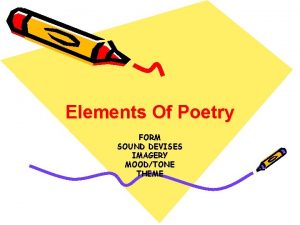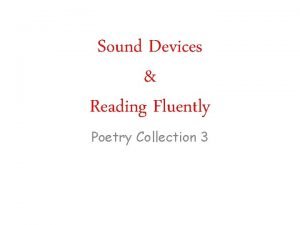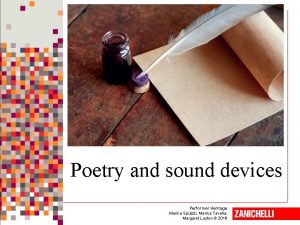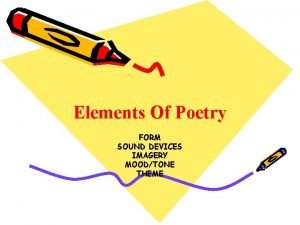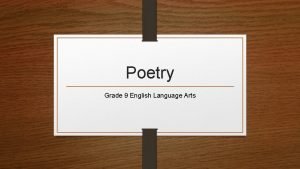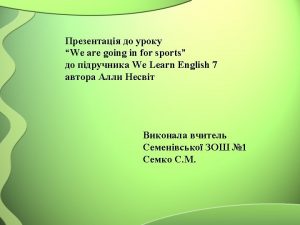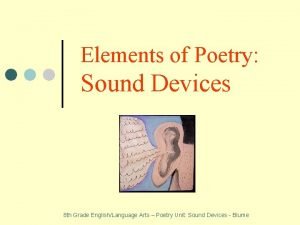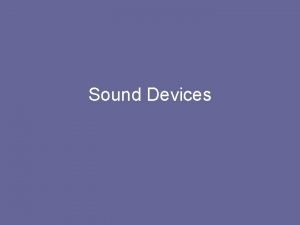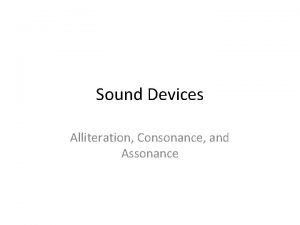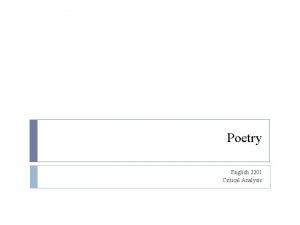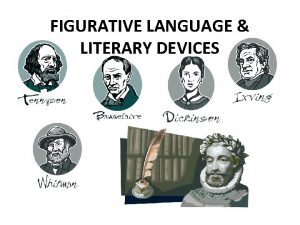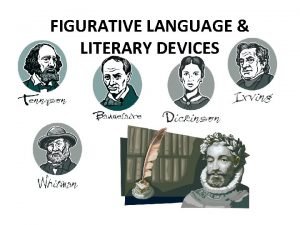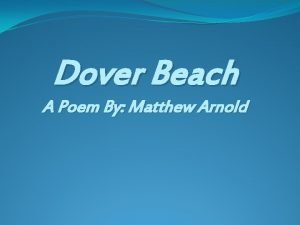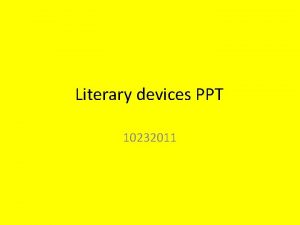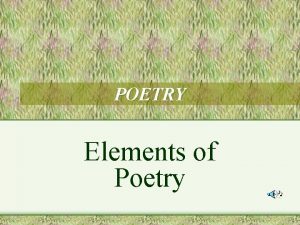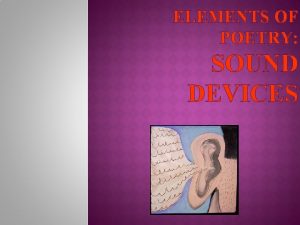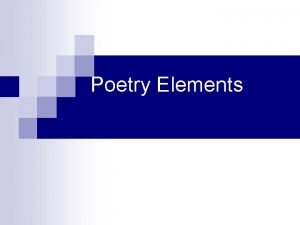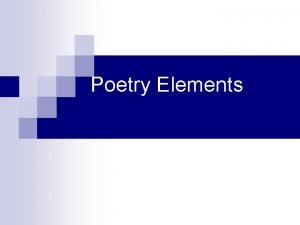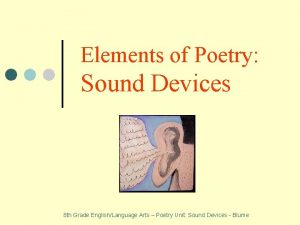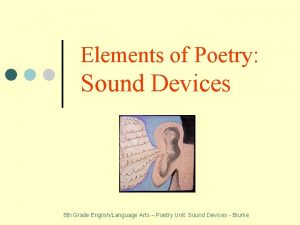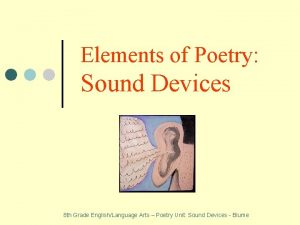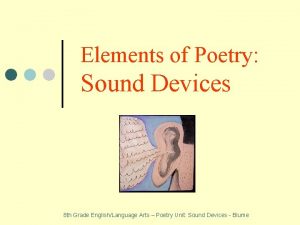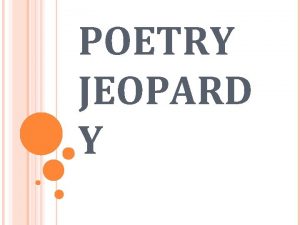Elements of Poetry Sound Devices 8 th Grade


















- Slides: 18

Elements of Poetry: Sound Devices 8 th Grade English/Language Arts – Poetry Unit: Sound Devices - Blume

Repetition s Think of all the song ds you know where wor ed – and lines are repeat often a lot ! Words or phrases repeated in writings to give emphasis, rhythm, and/or a sense of urgency. Example: from Edgar Allen Poe’s “The Bells” To the swinging and the ringing of the bells, bells – Of the bells, bells Bells, bells – To the rhyming and the chiming of the bells! 2

Alliteration The repetition of initial consonant sounds, in two or more neighboring words or syllables. The wild and wooly walrus waits and wonders when we will walk by. Slowly, silently, now the moon Walks the night in her silver shoon; This way, and that, she peers, and sees Silver fruit upon silver trees… -- from Silver by Walter de la Mare How much wood would a woodchuck if a woodchuck could chuck wood? (almost ALL tongue twisters!) 3

Alliteration examples 4

“Hear the music of voices, the song of a bird, the mighty strains of an orchestra, as if you would be stricken deaf tomorrow. Touch each object as if tomorrow your tactile sense would fail. Smell the perfume of flowers…” - from “Three Days to See” by Helen Keller Alliteration examples 5

Assonance This on NOT o e is usually nt but wh he CST Test , y not k now it? ! A repetition of vowel sounds within words or syllables. Fleet feet sweep by sleeping geese. Free and easy. Make the grade. The stony walls enclosed the holy space. 6

Assonance examples Poetry is old, ancient, goes back far. It is among the oldest of living things. So old it is that no man knows how and why the first poems came. --Carl Sandburg, Early Moon “…on a proud round cloud in white high night…” - E. E. Cummings “I made my way to the lake. ” 7

The Eagle Assonance example by Alfred Lord Tennyson He clasps the crag with crooked hands; Close to the sun in lonely lands, Ring'd with the azure world, he stands. The wrinkled sea beneath him crawls; He watches from his mountain walls, And like a thunderbolt he falls. 8

Rhythm and Meter ¢ Rhythm is the sound pattern of beats created by stressed and unstressed syllables. l The pattern can be regular or random. ¢ Meter is the regular patterns of stresses found in many poems and songs. ¢ Rhythm is often combined with rhyme, alliteration, and other poetic devices to add a musical quality to the writing. These sound devices can help to add pleasure to the ear and to create the mood and reveal the author’s tone. 9

Rhythm and Meter continued… Example: I think that I shall never see a poem lovely as a tree. The purple words/syllables are “stressed”, and they have a regular pattern, so this poetic line has “meter”. 10

Rhyme ¢ The repetition of end sounds in words l End rhymes appear at the end of two or more lines of poetry. l Internal rhymes appear within a single line of poetry. Ring around the rosies, A pocket full of posies, Abednego was meek and mild; he softly spoke, he sweetly smiled. He never called his playmates names, and he was good in running games; 11

How do rhymes effect a poem? ¢ ¢ ¢ 12 The sound effects created, for example a ‘musical’ quality; a jarring, discordant effect etc. It places emphasis on certain words, giving them a importance. It draws lines and stanzas together linking ideas and images. It creates a pattern. It can give a sense of ending or finality – the rhyming couplet is often used to give a sense of ending

Rhyme Scheme ¢ ¢ “also = a. a. k n as” know ¢ ¢ ¢ 13 The pattern of end rhymes (of lines) in a poem. Letters are used to identify a poem’s rhyme scheme (a. k. a rhyme pattern). The letter a is placed after the first line and all lines that rhyme with the first line. The letter b identifies the next line ending with a new sound, and all lines that rhyme with it. Letters continue to be assigned in sequence to lines containing new ending sounds. This may seem confusing, but it isn’t. Really!

Rhyme Scheme continued… Examples: Twinkle, twinkle little star How I wonder what you are. Up above the earth so high, Like a diamond in the sky. Baa, black sheep Have you any wool? Yes sir, yes sir, Three bags full. 14 a a b b a b c b

Rhyme Scheme continued… What is the rhyme scheme of this stanza? Whose woods these are I think I know. His house is in the village though; He will not see me stopping here To watch his woods fill up with snow. 15 From Stopping by Woods on a Snowy Evening by Robert Frost

Did you get it right? aaba Whose woods these are I think I know. His house is in the village though; He will not see me stopping here To watch his woods fill up with snow. 16 a a b a

17

Onomatopoeia Onom at consi opoeia is a dered lso sound a “poetic devic e”. Words that sound like their meaning --the “sound” they describe. buzz… hiss… roar… meow… woof… rumble… howl… snap… zip… zap… blip… whack … crack… crash… flutter… flap… squeak… whirr. . pow… plop… crunch… splash… jingle… rattle… clickety-clack… bam! 18
 What is sound devices
What is sound devices Sound devices examples
Sound devices examples Onomatopoeia poem definition
Onomatopoeia poem definition Assonance sound device
Assonance sound device Poem of imagery
Poem of imagery Sound devices definition poetry
Sound devices definition poetry Poetry and sound devices zanichelli
Poetry and sound devices zanichelli Form
Form Poems for grade 9 english
Poems for grade 9 english “a sound mind is in a sound body”
“a sound mind is in a sound body” Ehat is sound
Ehat is sound Which poetry element affects the poem's sound?
Which poetry element affects the poem's sound? Repetition of beginning sounds of words.
Repetition of beginning sounds of words. Assonance vs consonance
Assonance vs consonance The whaups poem analysis
The whaups poem analysis Assonance examples
Assonance examples Sound devices in a poem
Sound devices in a poem Sophocles dover beach
Sophocles dover beach Sound devices ppt
Sound devices ppt
